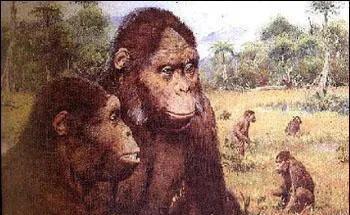Primitive society is the first stage of human history, which began more than three million years ago and ended at various times. Some scholars regard the transition from ape to man as the earliest stage of primitive society, and if so, the upper limit of primitive society can be traced back more than fourteen million years. But in general, it is not pushed up in this way, but the beginning of the "fully formed man" is taken as the beginning of primitive society.
In the late primitive society, with the development of the productive forces and the emergence of the social division of labor, there was a surplus of products, so private property and classes gradually arose, and the primitive clan tribal communes were replaced by slave states.
Humans and modern apes share a common ancestor, the ancient apes. It is generally believed that forest apes may be the common ancestor of humans and modern apes. Some scholars believe that the forest ape developed from the Egyptian ape.
In the middle of the geological Third Age, some ancient apes often moved to the ground in search of food, and gradually learned to walk upright with two feet, which also completed the first step from ape to man. In collective labour, there is an urgent need for a tool for exchanging ideas and expressing opinions, hence the emergence of language.

From ancient apes walking upright on the ground to being able to make tools with their hands, the transition period from apes to humans began about fourteen million years ago and ended more than three million years ago. Engels referred to the creatures of the transition from ape to man as "man in the making."
Most modern anthropologists believe that humans developed from one branch of australopithecus species, but some believe that another branch of Australopithecus australopithecus, australopithecus Affa, is the ancestor of humans.
After the transition from ape to man ends, the stage of "fully formed man" begins. Continental anthropologists divide it into four stages: early ape man, late ape man, early Homo sapiens, and late Homo sapiens.
The known early ape fossils were found in East Africa and date from about 3.8 million years ago to 1.8 million years ago. Late apes are also known as Homo erectus, and continents are commonly referred to as apes. It lived from about 1.8 million years ago to 300,000 or 200,000 years ago.
Early Homo sapiens, also known as the ancients, lived about 300,000 to about 50,000 or 40,000 years ago, the earliest attention of early Homo sapiens fossils was found in a cave in the Neanderthal Valley in Germany, so some people called early Homo sapiens Neanderthals, referred to as Neanderthals.
The last stage of human physical development is the late Homo sapiens, also known as the new man, including modern humans. Humans after 10,000 BC are generally referred to as modern humans.
When late Homo sapiens emerged, modern humans also formed. Anthropologists divide the world's people into three major races, namely the Mongolian, Europa, and Nigro races. The formation of the human race is the result of the influence of natural and historical conditions over a long period of time, and the argument that the human race is physically superior or inferior is unscientific.